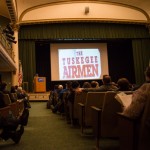
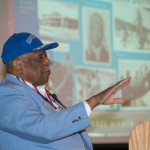
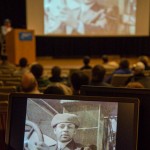
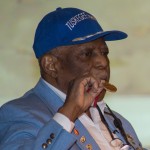
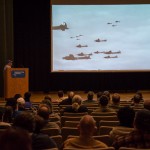 One of the famed Tuskegee Airmen, black pilots who flew in the face of prewar misconceptions and distinguished themselves in military service, shared a compelling history lesson with a Penn College audience on Tuesday afternoon. In a visit arranged by the Student Activities Office, Eugene J. Richardson Jr. – president of the Greater Philadelphia Chapter of Tuskegee Airmen Inc. and chair of its speakers bureau – detailed the hard-fought combat successes of African-American airmen in World War II. While he never personally saw battle, Richardson recounted the performance of those who did: members of the 332nd Fighter Group who ran airborne interference for white servicemen in the skies over Europe and North Africa. "They didn't know that the pilots were black," he said of the escorted bombardiers. "They just knew that they met you on time and protected you from the enemy." Among those accompanying Richardson to Williamsport was Aaron Watkins, a graduate of Tuskegee University and its aviation program, who is helping his mentor keep the story alive. While the service of the Tuskegee Airmen was depicted on screen in the George Lucas-produced "Red Tails," Richardson said he feels compelled to supplement that big-budget exposure with some old-school inspiration for a new generation. "These people look like you," he tells African-American youngsters during his frequent classroom visits. "They could do it; you can do it."
One of the famed Tuskegee Airmen, black pilots who flew in the face of prewar misconceptions and distinguished themselves in military service, shared a compelling history lesson with a Penn College audience on Tuesday afternoon. In a visit arranged by the Student Activities Office, Eugene J. Richardson Jr. – president of the Greater Philadelphia Chapter of Tuskegee Airmen Inc. and chair of its speakers bureau – detailed the hard-fought combat successes of African-American airmen in World War II. While he never personally saw battle, Richardson recounted the performance of those who did: members of the 332nd Fighter Group who ran airborne interference for white servicemen in the skies over Europe and North Africa. "They didn't know that the pilots were black," he said of the escorted bombardiers. "They just knew that they met you on time and protected you from the enemy." Among those accompanying Richardson to Williamsport was Aaron Watkins, a graduate of Tuskegee University and its aviation program, who is helping his mentor keep the story alive. While the service of the Tuskegee Airmen was depicted on screen in the George Lucas-produced "Red Tails," Richardson said he feels compelled to supplement that big-budget exposure with some old-school inspiration for a new generation. "These people look like you," he tells African-American youngsters during his frequent classroom visits. "They could do it; you can do it."